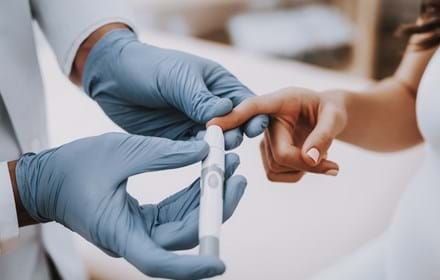
DRWF Research: How a low carbohydrate diet could promote meaningful weight loss
The Diabetes UK Professional Conference is underway. Read Day Two of DRWF Research Manager Dr Eleanor Kennedy’s blog reports from the event
The second day of this two-week conference is dominated by another prize lecture. This time it’s the Harry Keen Rank Nutrition Lecture. This lecture is in memory of Professor Harry Keen who died in 2013.
Professor Keen was a physician and epidemiologist who did much to shape the modern understanding of diabetes and its treatment. He was a giant in the diabetes world, and I’m delighted to say that I knew him well and had often met him, delighting in his stories of his early research career. His name is now attached to a prize lecture specifically focused on nutrition and this year’s winner, Dr Denise Robertson, kicks off Day Two with her talk entitled The 21st century “rediscovery” of dietary fibre: From bedside to bench to bacteria, and back again.
Dr Robertson begins by explaining that cereals have been cultivated in the UK since around 4000 BC. Although in the present day, we generally eat 15-20g of fibre per day, we used to eat about 100g per day, more from necessity rather than from virtue. This means that we have both the capacity and the tolerance to increase the amount of fibre in our diets. We just choose not to. Interestingly, there was a drop in the incidence of type 2 diabetes during the Second World War thanks, in large part, to rationing. It took until 1956, just three years after the end of rationing, to witness diabetes rates increasing again after the reintroduction of white flour.
Are all fibres structurally and functionally the same?
In short, no. There are issues like molecular size to consider as well as the pattern of resulting microbial metabolites, but it is the differences in the fermentation processes by gut bacteria that is really important. The main metabolites from these processes are short chain fatty acids – acetate, propionate and butyrate. These short chain fatty acids are key mediators in improving insulin sensitivity in the muscle and in the liver.
The human microbiome has changed how we deal with fibre as well. Indeed, this is now a huge, and increasingly complex, field of research in the world of diabetes and beyond. Research is now pointing towards a role for the gut in the onset of type 2 diabetes. In animal models, nutritional or genetic obesity leads to an alteration in gut microbiota, and this can damage the endothelium that lines the gut. This, in turn, makes it more permeable allowing other molecules to cross the barrier into the bloodstream leading to low grade inflammation, insulin resistance and, ultimately, type 2 diabetes.
Can we increase fibre intake amongst the general population?
If current trajectories with food choices are to continue, then probably not. Could we instead encourage administration of oral short chain fatty acids? Again, probably not, because they have what is politely termed “poor organoleptic properties”. In other words, they taste and smell absolutely awful! Moreover, they would be absorbed in the upper small intestine, yet their site of action is in the colon so targeted delivery to the large intestine would be necessary for full functionality.
Resistant starch
It is here that I am introduced to a new concept – resistant starch. It’s structurally a starch but functionally a dietary fibre and is already found in items like whole grains, beans and bananas but it can be added to food. Some research exists to suggest that it can reduce postprandial glycaemic responses and even type 2 diabetes, however I fear that the jury is still out on this one!
Dr Robertson’s take home message is that we need to be producing high fibre products, perhaps through the utilisation of resistant starch, which are identical and/or acceptable to the general population – a “health by stealth”.
Type 2 diabetes remission
Diet is just one of the ways that we can control our weight and, in an interesting debate the following day What is the best way to achieve type 2 diabetes remission?, three heavyweights (if you’ll pardon the pun!) discussed this.
Professor Mike Lean talked about the DiRECT study, Dr Nicola Guess went up to bat for a low carbohydrate diet and Professor Carel le Roux spoke in favour of gastric bypass surgery.
It is well-documented that the DiRECT trial, a very low-calorie diet intervention, resulted in a mean weight loss of 8kg, lower HbA1c and blood pressure readings with fewer of the study participants on medication and, importantly, a better quality of life after 24 months compared to the control group.
The next speaker, DRWF-funded researcher Dr Nicola Guess, of King's College London, proposed that it is really only a low carbohydrate, rather than a low-calorie diet, that could promote meaningful weight loss simply because it does not just rely on weight loss. It also promotes a robust insulin response, lowers the amount of fat in the liver and lowers endogenous glucose production and she concluded by saying that she believes that this could offer hope for people with type 2 diabetes of longer duration.
Finally, Professor Le Roux concluded that bariatric, or metabolic, surgery is currently the best method to achieve long-term remission of diabetes but conceded that surgery alone is not good enough. Combining surgery with lifestyle changes and medication is likely to be far superior to any other option on its own.
It is an interesting conclusion in that really no one way will be the optimal one thanks to the individuality of diabetes as a condition and it really should be a combination of self-help programmes, structured education, best medial practice and surgical options.
And that is something that all three speakers can agree on!
Read Lockdown guidance for staying home and safe for people living with diabetes during Covid-19 pandemic
Read How people with diabetes could become more ill if diagnosed with Covid-19
DRWF operations during the Covid-19 health crisis
The DRWF team is working remotely. Covid-19 guidance, particularly where it aligns or impacts with diabetes guidance, is shared as quickly as possible through the DRWF website and social media channels with the aim of making it as easy to understand as possible and a reliable source of latest news.
Further reports to follow – visit DRWF news page
Follow Dr Eleanor Kennedy on Twitter: @DRWFEleanor
Support DRWF by making a donation here
Find out more about DRWF-funded research here
Find out more about DRWF fundraising here
For latest update follow DRWF on Facebook, Instagram and Twitter
To receive the charity’s latest bulletins as they become available, please sign up here
Read DRWF diabetes information leaflets here
Join the Diabetes Wellness Network here
Recent News


